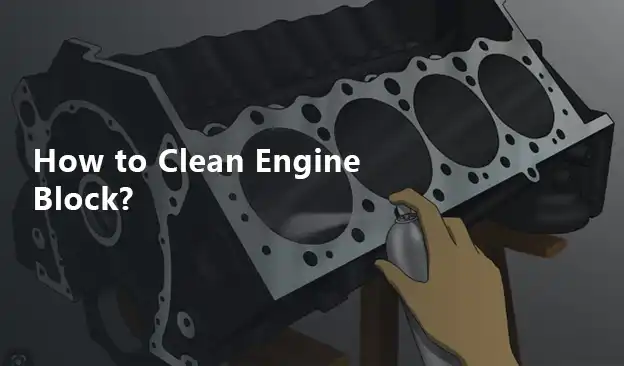How to Clean Engine Block?
The engine block will directly affect the output power of the engine. After the vehicle is used for a period of time, it will generate a lot of oil or carbon deposits, which will block the cylinder block and affect fuel efficiency and power. The following are several common cylinder block cleaning methods.
Cylinder block removal
1. Unscrew the 10 fixing screws of the cylinder head from the outside to the inside and lift down the cylinder head.
2. Remove the cylinder gasket and pay attention to the installation direction of the cylinder gasket.
3. Loosen the oil drain bolt of the oil pan to drain the oil in the oil pan.
4. Turn over the engine and remove the fixing bolts of the oil pan (note that the bolts also need to be loosened from both ends toward the middle). Remove the oil pan and oil pan gasket.
5. Loosen the fixing bolts of the primary oil filter and remove the oil filter, oil pump sprocket, and oil pump.
How to clean the engine block after machining?
Generally, the commonly used methods are dismantling and washing, clearing the hanging bottle, and fuel additives.
- Dismantling and washing: This method is very direct and rough, but it is generally sent to a professional cylinder block for sale repair shop. The dismantling of the engine is relatively complicated, and no matter what parts are disassembled every time, it will affect its performance more or less. You need to ask a professional master to disassemble it. Dismantling and washing are relatively straightforward to see the carbon deposits in the engine, and the cleaning will be relatively clean. But the cost will be relatively high, and it also requires technology.
- Bottle cleaning: This method is also relatively common. When the cleaning agent is discharged into the air intake, the cleaning agent is diluted and softened to turn it into a slurry, and then burned and discharged from the cylinder. The general cleaning objects include the intake port, throttle valve, intake valve, fuel injector, cylinder interior, etc., but the effect is not as direct and obvious as dismantling and washing.
- Fuel additives: one reason for carbon deposits is that the fuel is not fully burned and adheres to various parts of the engine, forming carbon deposits over time. The main function of the additive is to use strong surface activity to drill into the pores of carbon deposits, destroy their structure, gradually dissolve these carbon deposit particles from the metal surface, burn them with fuel at high temperatures and then discharge them through exhaust gas. This kind of additive that sounds miraculous is actually not very effective. Carbon deposits often occur on the top of the cylinder and the bottom of the cylinder head, which will cause early combustion of the gasoline engine and accelerate the wear of the cylinder. The carbon deposit in the body group can be observed directly with the eyes. There are two kinds of carbon deposit removal, mechanical method, and chemical method. Generally, the combination of the two methods is better. The mechanical method directly uses a wire brush or scraper to remove (be careful not to scratch the body group). The chemical method is to use chemical solvents (see the table below) to soak the carbon deposits in the unit for 2 to 3 hours. The effect of heating and soaking is better to soften the carbon deposits, and then using a brush to remove them.
Best Way To Clean An Engine Block
Cleaning an engine block is one of the most important tasks in maintaining the engine performance and prolonging the life of mechanical equipment. Here are the best way to clean an engine block:
1. Regular oil and filter replacement is one of the key steps to keep the engine clean. This is indispensable for cleaning an engine block. The oil helps reduce friction while attracting and suspending dirt and particles, preventing them from depositing on the cylinder walls.
2. Choosing high-quality fuel can reduce carbon deposits in the engine. Avoid low-quality fuels as they may contain impurities that can cause cylinder volume carbon.
3. Clean the air filter to prevent dust and impurities from entering the engine. This helps prevent particulate matter from adhering to the cylinder walls.
4. Regular use of a fuel system cleaner can help remove carbon deposits from fuel injectors and intake tracts. Follow the professional craftsman's advice and add cleaner to the tank on a regular basis.
5. Regularly check and replace spark plugs, the condition of spark plugs is crucial to engine performance. If spark plugs are worn or contaminated, they can cause incomplete combustion, producing carbon deposits. This can make cleaning an engine block unnecessarily difficult.
| Inorganic Solvent Formulation | Organic Solvent Formulation | |||
|---|---|---|---|---|
| Solvent composition | steel parts/kg | aluminum alloy parts/kg | Solvent composition | quality/% |
| sodium hydroxide | 2.5 | gasoline | 8 | |
| Sodium carbonate | 3.3 | 1.85 | coal oil | 22 |
| Sodium silicate | 0.15 | 0.85 | turpentine | 15 |
| Soap | 0.88 | 1 | phenol | 30 |
| Oleic acid | 8 | |||
 Track Your Order
Track Your Order




